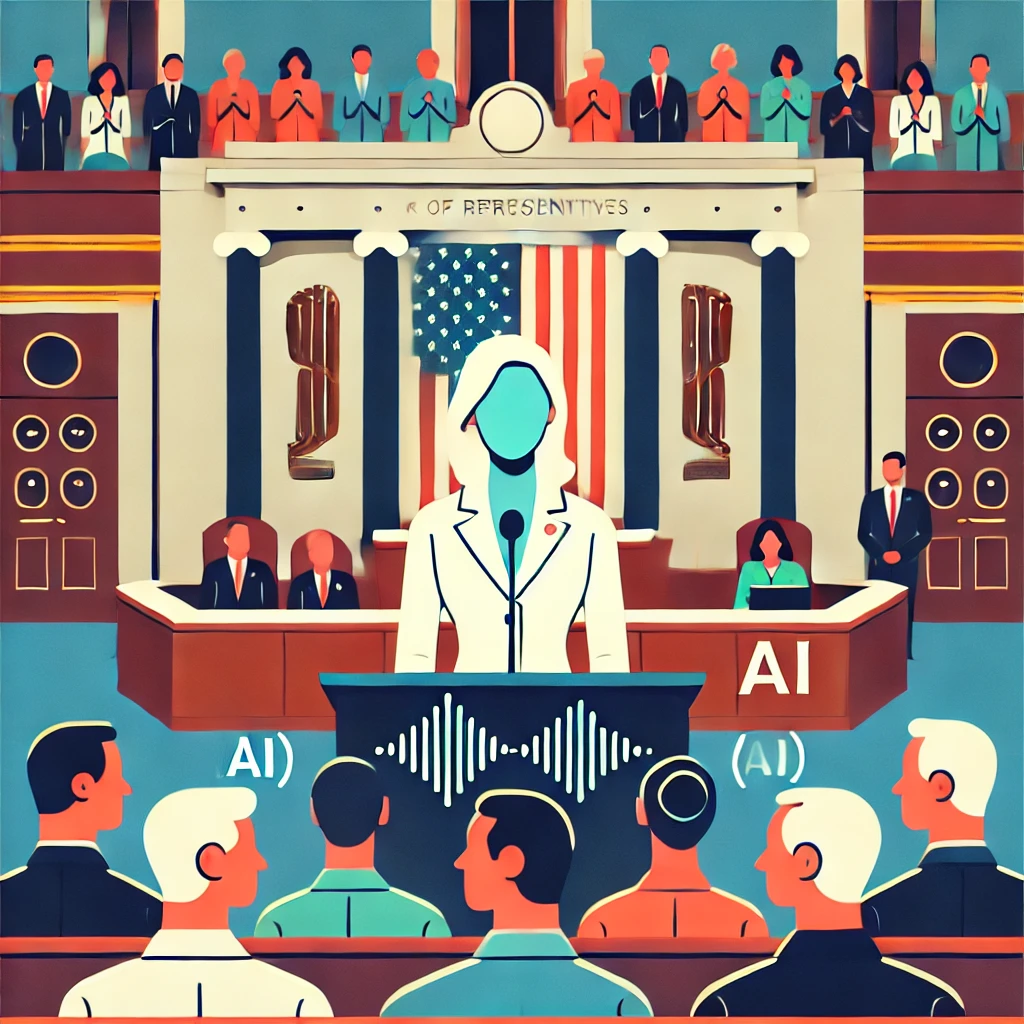On Thursday, Virginia Congresswoman Jennifer Wexton made a groundbreaking address to the House of Representatives using an artificial intelligence (AI) voice clone. This innovative technology allowed her to replicate her own voice from previous recordings, enabling her to communicate effectively despite her recent diagnosis of progressive supranuclear palsy, a condition that severely impacts her ability to speak. Wexton’s use of AI marks a significant moment in congressional history, as she appears to be the first individual to deliver a speech on the House floor using a voice generated by AI.
Wexton’s condition has posed considerable challenges for her, particularly in terms of verbal communication. Progressive supranuclear palsy is a rare neurological disorder that affects movement, balance, and speech. By utilizing AI technology, Wexton has found a way to overcome some of these barriers, allowing her to continue participating in legislative discussions and advocating for her constituents. The AI program she employed was able to analyze her past speeches and create a voice model that closely resembles her natural speaking tone.
The implications of Wexton’s use of AI in Congress extend beyond her personal circumstances. This event raises important questions about the future of technology in political discourse and the potential for AI to assist individuals with disabilities. As AI continues to evolve, it may provide new avenues for communication and representation, allowing more voices to be heard in legislative processes. Wexton’s pioneering approach could inspire other lawmakers facing similar challenges to explore the use of technology in their own advocacy efforts.
Moreover, Wexton’s speech serves as a reminder of the importance of accessibility in politics. The ability to communicate effectively is crucial for lawmakers to fulfill their responsibilities and engage with their constituents. By embracing AI technology, Wexton not only enhances her own ability to participate but also highlights the need for inclusive practices within governmental institutions. This could lead to broader discussions about how technology can be leveraged to support individuals with disabilities in various fields.
In conclusion, Jennifer Wexton’s use of an AI voice clone to address Congress represents a significant advancement in both technology and accessibility. It showcases the potential of AI to empower individuals with speech impairments and underscores the importance of inclusive practices in political representation. As society continues to navigate the intersection of technology and communication, Wexton’s experience may pave the way for future innovations that promote greater inclusivity and engagement in the political arena.
Original news source: Lawmaker uses AI voice clone to address Congress (BBC)
🎧 Listen:
Slow
Normal
Fast
📖 Vocabulary:
| 1 | groundbreaking | Introducing new and innovative ideas or methods |
| 2 | replicate | To make an exact copy or reproduction of something |
| 3 | diagnosis | The identification of the nature of an illness or other problem |
| 4 | progressive | Developing gradually over time |
| 5 | neurological | Relating to the nervous system |
| 6 | constituents | People who live in a particular area and are represented by an elected official |
| 7 | implications | The possible effects or results of an action or decision |
| 8 | discourse | Written or spoken communication or debate |
| 9 | evolve | To develop or change gradually over time |
| 10 | avenues | Different ways or paths to achieve something |
| 11 | pioneering | Being the first to use or apply a new method or idea |
| 12 | accessibility | The quality of being easy to approach, reach, or use |
| 13 | inclusive | Including all types of people and treating them equally |
| 14 | leveraged | Utilized or made use of for a particular purpose |
| 15 | impairments | Weaknesses or limitations in function or ability |
Group or Classroom Activities
Warm-up Activities:
– CHARADES
Instructions: Divide the class into small groups. Each group takes turns acting out key concepts or terms from the article (e.g., AI, speech, accessibility) without speaking, while the other groups guess what it is. This helps reinforce vocabulary and comprehension through movement and interaction.
– OPINION POLL
Instructions: Create a set of statements related to the themes of the article, such as “AI technology should be used in political settings.” Have students walk around the room, asking their classmates to agree or disagree with each statement. Afterward, discuss the results and students’ opinions as a class.
– MIND MAP
Instructions: In small groups, students will create a mind map on a large piece of paper that visualizes the main ideas and implications of the article. They should include connections between Wexton’s use of AI, its impact on accessibility, and future predictions for technology in politics.
– TWO TRUTHS AND A LIE
Instructions: Students will write down two true statements and one false statement related to the article’s content. They will then share their statements with a partner, who must identify which one is the lie. This activity encourages critical thinking and comprehension of the article’s details.
– HEADLINE CREATION
Instructions: Students will create catchy headlines that summarize the article’s main points. They should aim to be concise and engaging, as if they are writing for a news outlet. Afterward, students can share their headlines in small groups or with the class, discussing the different angles they chose to emphasize.
🤔 Comprehension Questions:
1. What condition was Congresswoman Jennifer Wexton diagnosed with, and how does it affect her communication abilities?
2. How did Wexton utilize artificial intelligence to deliver her speech in Congress?
3. What significance does Wexton’s use of AI hold in the context of congressional history?
4. In what ways does Wexton’s experience with AI technology highlight the importance of accessibility in politics?
5. How might Wexton’s use of AI inspire other lawmakers who face similar challenges?
6. What are some potential implications of AI technology in political discourse, as suggested by Wexton’s address?
7. How does the AI program used by Wexton create a voice model that resembles her natural speaking tone?
8. What broader discussions could Wexton’s speech prompt regarding technology and support for individuals with disabilities in various fields?
Go to answers ⇩
🎧✍️ Listen and Fill in the Gaps:
On Thursday, Virginia Congresswoman Jennifer Wexton made a groundbreaking address to the House of Representatives using an artificial intelligence (AI) voice clone. This innovative technology allowed her to replicate her own voice from previous recordings, enabling her to communicate effectively despite her recent diagnosis of progressive supranuclear palsy, a condition that severely (1)______ her ability to speak. Wexton’s use of AI marks a significant moment in congressional history, as she appears to be the first individual to deliver a speech on the House (2)______ using a voice (3)______ by AI.
Wexton’s condition has posed (4)______ challenges for her, particularly in terms of verbal communication. Progressive supranuclear palsy is a rare neurological disorder that affects movement, balance, and speech. By utilizing AI technology, Wexton has found a way to overcome some of these barriers, allowing her to continue participating in legislative (5)______ and advocating for her constituents. The AI program she employed was able to analyze her past speeches and create a voice model that closely resembles her (6)______ speaking tone.
The implications of Wexton’s use of AI in (7)______ extend beyond her personal circumstances. This event raises important questions about the future of technology in (8)______ discourse and the potential for AI to assist individuals with disabilities. As AI continues to evolve, it may provide new avenues for communication and representation, allowing more voices to be heard in legislative processes. Wexton’s pioneering approach could (9)______ other lawmakers facing similar challenges to explore the use of (10)______ in their own advocacy efforts.
Moreover, Wexton’s speech serves as a reminder of the importance of accessibility in (11)______. The ability to communicate effectively is crucial for lawmakers to fulfill their responsibilities and engage with their constituents. By embracing AI technology, Wexton not only enhances her own ability to participate but also highlights the need for inclusive (12)______ within governmental institutions. This could lead to broader discussions about how technology can be leveraged to support individuals with disabilities in various fields.
In conclusion, (13)______ Wexton’s use of an AI voice (14)______ to address Congress (15)______ a significant advancement in both technology and (16)______. It showcases the potential of AI to empower individuals with speech impairments and underscores the importance of inclusive practices in political representation. As society continues to navigate the intersection of technology and communication, Wexton’s experience may pave the way for future innovations that promote greater inclusivity and engagement in the political arena.
Go to answers ⇩
💬 Discussion Questions:
Students can ask a partner these questions, or discuss them as a group.
1. What is your opinion on the use of AI technology in political settings? Do you think it is beneficial or harmful? Why?
2. How would you feel if you had to use technology to communicate due to a medical condition? Would it empower you or make you feel limited?
3. Do you think that AI can truly replicate the nuances of human speech and emotion? Why or why not?
4. What are some potential ethical concerns regarding the use of AI in communication, especially in politics?
5. Have you ever experienced a situation where technology helped you overcome a personal challenge? Can you share your experience?
6. Do you believe that all individuals, regardless of their abilities, should have equal access to technology that aids communication? Why or why not?
7. How would you feel if AI technology became a common tool for public speaking? Would you embrace it or resist it?
8. What is a significant challenge you think people with disabilities face in your country? How might technology help address this?
9. Do you think that lawmakers should be required to use accessible technology in their communications? Why or why not?
10. How do you see the role of AI evolving in the next decade, especially in terms of accessibility for individuals with disabilities?
11. What is your perspective on the balance between human communication and AI-generated communication? Do you think one is more valuable than the other?
12. Have you ever felt excluded from a conversation or event due to communication barriers? How did that affect you?
13. Do you think that innovations like AI voice cloning could change the way we perceive public figures and politicians? Why or why not?
14. What is a way in which you think society could improve accessibility for people with disabilities beyond technology?
15. How would you feel if your voice could be replicated by AI? Would you find it comforting or unsettling? Why?
Individual Activities
📖💭 Vocabulary Meanings:
Match each word to its meaning.
Words:
1. groundbreaking
2. replicate
3. diagnosis
4. progressive
5. neurological
6. constituents
7. implications
8. discourse
9. evolve
10. avenues
11. pioneering
12. accessibility
13. inclusive
14. leveraged
15. impairments
Meanings:
(A) Weaknesses or limitations in function or ability
(B) Relating to the nervous system
(C) To develop or change gradually over time
(D) Written or spoken communication or debate
(E) Being the first to use or apply a new method or idea
(F) The identification of the nature of an illness or other problem
(G) The quality of being easy to approach, reach, or use
(H) People who live in a particular area and are represented by an elected official
(I) To make an exact copy or reproduction of something
(J) Introducing new and innovative ideas or methods
(K) Developing gradually over time
(L) Including all types of people and treating them equally
(M) The possible effects or results of an action or decision
(N) Different ways or paths to achieve something
(O) Utilized or made use of for a particular purpose
Go to answers ⇩
🔡 Multiple Choice Questions:
1. Who made a groundbreaking address to the House of Representatives using an AI voice clone?
(a) Nancy Pelosi
(b) Alexandria Ocasio-Cortez
(c) Jennifer Wexton
(d) Kamala Harris
2. What condition has Jennifer Wexton been diagnosed with?
(a) Multiple sclerosis
(b) Progressive supranuclear palsy
(c) Amyotrophic lateral sclerosis
(d) Parkinson’s disease
3. What does progressive supranuclear palsy affect?
(a) Memory and cognition
(b) Vision and hearing
(c) Heart rate and blood pressure
(d) Movement, balance, and speech
4. What technology did Wexton use to deliver her speech?
(a) Speech recognition software
(b) Video conferencing tools
(c) Augmentative communication devices
(d) AI voice clone
5. What significant moment does Wexton’s use of AI represent in congressional history?
(a) First speech delivered by a woman
(b) First speech delivered remotely
(c) First speech delivered using AI
(d) First speech on disability rights
6. What does Wexton’s use of AI highlight in terms of political practices?
(a) The need for accessibility
(b) The importance of traditional communication methods
(c) The effectiveness of public speaking training
(d) The role of social media in politics
7. What potential does AI have according to the article?
(a) To replace human lawmakers
(b) To assist individuals with disabilities
(c) To streamline legislative processes
(d) To enhance political campaigns
8. What does Wexton’s experience suggest about the future of technology in politics?
(a) It may promote greater inclusivity and engagement
(b) It will lead to fewer in-person discussions
(c) It will complicate communication
(d) It will reduce the need for lawmakers to speak publicly
Go to answers ⇩
🕵️ True or False Questions:
1. Wexton is believed to be the second person to use AI-generated voice technology for a speech on the House floor.
2. Wexton’s experience with AI technology may inspire other lawmakers facing similar challenges to adopt innovative solutions for communication.
3. Virginia Congresswoman Jennifer Wexton delivered a speech to the House of Representatives using an artificial intelligence voice clone.
4. Progressive supranuclear palsy is a rare neurological disorder that impacts movement, balance, and speech.
5. The AI technology used by Wexton replicated her voice from previous recordings.
6. Wexton has been misdiagnosed with progressive supranuclear palsy, which affects her ability to speak.
7. The event overlooks the importance of accessibility in politics and the need for inclusive practices within governmental institutions.
8. Wexton’s use of AI raises answers about the role of technology in political discourse and support for individuals with disabilities.
Go to answers ⇩
📝 Write a Summary:
Write a summary of this news article in two sentences.
Check your writing now with the best free AI for English writing!
Writing Questions:
Answer the following questions. Write as much as you can for each answer.
Check your answers with our free English writing assistant!
1. How did Jennifer Wexton utilize AI technology to address the House of Representatives despite her speech impairment?
2. What challenges does progressive supranuclear palsy present for individuals in terms of communication?
3. In what ways could Wexton’s use of AI in Congress influence future political discourse and representation for individuals with disabilities?
4. What does Wexton’s experience reveal about the importance of accessibility in political institutions?
5. How might advancements in AI technology continue to impact communication and advocacy for lawmakers facing similar challenges as Wexton?
✅ Answers
🤔✅ Comprehension Question Answers:
1. What condition was Congresswoman Jennifer Wexton diagnosed with, and how does it affect her communication abilities?
Wexton was diagnosed with progressive supranuclear palsy, a rare neurological disorder that severely impacts her ability to speak, as well as affecting movement and balance.
2. How did Wexton utilize artificial intelligence to deliver her speech in Congress?
Wexton used an AI voice clone that replicated her own voice from previous recordings, allowing her to communicate effectively despite her speech difficulties.
3. What significance does Wexton’s use of AI hold in the context of congressional history?
Wexton’s use of AI marks a significant moment in congressional history as she appears to be the first individual to deliver a speech on the House floor using a voice generated by AI.
4. In what ways does Wexton’s experience with AI technology highlight the importance of accessibility in politics?
Wexton’s experience emphasizes the need for effective communication in politics, showcasing how AI technology can enhance participation and representation for individuals with disabilities.
5. How might Wexton’s use of AI inspire other lawmakers who face similar challenges?
Wexton’s pioneering approach could encourage other lawmakers with speech impairments or similar challenges to explore the use of technology in their advocacy efforts, promoting greater inclusivity.
6. What are some potential implications of AI technology in political discourse, as suggested by Wexton’s address?
Wexton’s address raises questions about the future role of AI in political discourse, particularly in assisting individuals with disabilities and providing new avenues for communication and representation.
7. How does the AI program used by Wexton create a voice model that resembles her natural speaking tone?
The AI program analyzes her past speeches to create a voice model that closely resembles her natural speaking tone, allowing for a more authentic delivery.
8. What broader discussions could Wexton’s speech prompt regarding technology and support for individuals with disabilities in various fields?
Wexton’s speech could prompt discussions about how technology can be leveraged to support individuals with disabilities, leading to inclusive practices in politics and other fields, and exploring innovative solutions for communication challenges.
Go back to questions ⇧
🎧✍️✅ Listen and Fill in the Gaps Answers:
(1) impacts
(2) floor
(3) generated
(4) considerable
(5) discussions
(6) natural
(7) Congress
(8) political
(9) inspire
(10) technology
(11) politics
(12) practices
(13) Jennifer
(14) clone
(15) represents
(16) accessibility
Go back to questions ⇧
📖💭✅ Vocabulary Meanings Answers:
1. groundbreaking
Answer: (J) Introducing new and innovative ideas or methods
2. replicate
Answer: (I) To make an exact copy or reproduction of something
3. diagnosis
Answer: (F) The identification of the nature of an illness or other problem
4. progressive
Answer: (K) Developing gradually over time
5. neurological
Answer: (B) Relating to the nervous system
6. constituents
Answer: (H) People who live in a particular area and are represented by an elected official
7. implications
Answer: (M) The possible effects or results of an action or decision
8. discourse
Answer: (D) Written or spoken communication or debate
9. evolve
Answer: (C) To develop or change gradually over time
10. avenues
Answer: (N) Different ways or paths to achieve something
11. pioneering
Answer: (E) Being the first to use or apply a new method or idea
12. accessibility
Answer: (G) The quality of being easy to approach, reach, or use
13. inclusive
Answer: (L) Including all types of people and treating them equally
14. leveraged
Answer: (O) Utilized or made use of for a particular purpose
15. impairments
Answer: (A) Weaknesses or limitations in function or ability
Go back to questions ⇧
🔡✅ Multiple Choice Answers:
1. Who made a groundbreaking address to the House of Representatives using an AI voice clone?
Answer: (c) Jennifer Wexton
2. What condition has Jennifer Wexton been diagnosed with?
Answer: (b) Progressive supranuclear palsy
3. What does progressive supranuclear palsy affect?
Answer: (d) Movement, balance, and speech
4. What technology did Wexton use to deliver her speech?
Answer: (d) AI voice clone
5. What significant moment does Wexton’s use of AI represent in congressional history?
Answer: (c) First speech delivered using AI
6. What does Wexton’s use of AI highlight in terms of political practices?
Answer: (a) The need for accessibility
7. What potential does AI have according to the article?
Answer: (b) To assist individuals with disabilities
8. What does Wexton’s experience suggest about the future of technology in politics?
Answer: (a) It may promote greater inclusivity and engagement
Go back to questions ⇧
🕵️✅ True or False Answers:
1. Wexton is believed to be the second person to use AI-generated voice technology for a speech on the House floor. (Answer: False)
2. Wexton’s experience with AI technology may inspire other lawmakers facing similar challenges to adopt innovative solutions for communication. (Answer: True)
3. Virginia Congresswoman Jennifer Wexton delivered a speech to the House of Representatives using an artificial intelligence voice clone. (Answer: True)
4. Progressive supranuclear palsy is a rare neurological disorder that impacts movement, balance, and speech. (Answer: True)
5. The AI technology used by Wexton replicated her voice from previous recordings. (Answer: True)
6. Wexton has been misdiagnosed with progressive supranuclear palsy, which affects her ability to speak. (Answer: False)
7. The event overlooks the importance of accessibility in politics and the need for inclusive practices within governmental institutions. (Answer: False)
8. Wexton’s use of AI raises answers about the role of technology in political discourse and support for individuals with disabilities. (Answer: False)
Go back to questions ⇧













